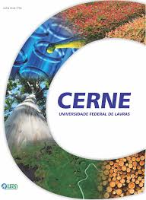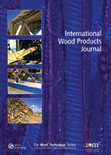
MOKUZAI GAKKAISHI
Scope & Guideline
Connecting Scholars to the Future of Wood Science
Introduction
Aims and Scopes
- Wood Properties and Performance:
Research in this area examines the mechanical, physical, and chemical properties of various wood species, including their behavior under different conditions. This includes studies on strength, elasticity, and durability, which are critical for both construction and product development. - Wood Processing Technologies:
This scope covers advancements in technologies related to wood processing, including methods for improving wood treatment, preservation, and bonding techniques. Innovations in adhesive formulations and processing methods are significant for enhancing wood product performance. - Environmental Impact and Sustainability:
The journal addresses the ecological implications of wood utilization, including life cycle assessments (LCA) and the sustainability of wood as a renewable resource. Studies often focus on the carbon footprint of wood products and their role in climate change mitigation. - Biological Interactions and Wood Decay:
Research related to the biological aspects of wood, including studies on wood decay, the effects of fungi and insects, and the development of bio-based preservatives, is a crucial part of the journal's scope. This area emphasizes understanding natural processes that can affect wood longevity. - Cultural and Historical Aspects of Wood Utilization:
The journal also explores the cultural significance of wood, including studies on historical wood usage and conservation of wooden artifacts. This area highlights the intersection of wood science with cultural heritage.
Trending and Emerging
- Sustainability and Carbon Management:
There is an increasing focus on the sustainability of wood products and their role in carbon management. Research is expanding into how wood can be utilized to mitigate climate change, including studies on carbon stocks in harvested wood products. - Advanced Wood Processing Technologies:
Emerging studies highlight significant advancements in wood processing technologies, including new methods for enhancing the performance of engineered wood products like cross-laminated timber (CLT) and innovations in adhesive technologies. - Health and Psychological Effects of Wood Materials:
Recent publications have begun exploring the physiological and psychological impacts of wood in built environments. This includes studies on how different wood types affect human comfort and well-being, indicating a growing intersection between wood science and human factors. - Utilization of Biomass and Waste Materials:
Research on the utilization of wood biomass and waste products is gaining traction. This includes studies on the conversion of wood waste into valuable materials and energy, reflecting a broader interest in resource efficiency. - Innovations in Wood Preservation and Durability:
There is a notable trend towards developing new preservation methods to enhance the durability of wood products. This includes research on fire retardancy and resistance to biological decay, indicating a proactive approach to prolonging the life of wood materials.
Declining or Waning
- Traditional Wood Utilization Techniques:
Research that focuses on ancient or traditional methods of utilizing wood has decreased, possibly due to the shift towards modern techniques and materials that prioritize efficiency and sustainability over historical practices. - Basic Biological Studies of Lesser-known Species:
There has been a noticeable decline in studies focusing on lesser-known or underutilized wood species. As the emphasis shifts towards more commercially viable and widely used species, research on these lesser-known varieties has diminished. - Wood Artifacts and Cultural Studies:
While cultural aspects of wood are still relevant, the specific focus on the conservation and study of wooden artifacts and their historical contexts seems to be less frequently represented in recent publications.
Similar Journals

BioResources
Exploring the synergy of bioengineering and environmental stewardship.BioResources is a pioneering open access journal launched in 2006, dedicated to disseminating knowledge at the intersection of bioengineering, environmental engineering, and waste management. Published by NORTH CAROLINA STATE UNIVERSITY DEPARTMENT OF WOOD & PAPER SCIENCE, this journal serves as a vital platform for researchers and professionals to explore the sustainable use of biomaterials and renewable resources. With an impact reflected through its Scopus rankings, including a respectable position in the 2023 quartile rankings across several relevant categories, BioResources is committed to advancing scientific discourse and enhancing the understanding of bioresource utilization. The journal not only supports high-quality research but also encourages contributions that shape environmental policies and practices. Accessible globally, it invites active participation from scholars aiming to contribute to a more sustainable future. Researchers, professionals, and students alike will find valuable insights and groundbreaking research within its pages as it continues to foster knowledge and innovation in the field.

CANADIAN JOURNAL OF FOREST RESEARCH
Transforming challenges into opportunities in forest research.Canadian Journal of Forest Research (ISSN: 0045-5067, E-ISSN: 1208-6037), published by Canadian Science Publishing, stands as a leading platform for disseminating cutting-edge research in the field of forestry and ecological sciences. With an impressive impact factor and a steady reputation for high-quality publications, this journal occupies a prestigious position indicated by its Q1 ranking in Forestry and Q2 in Ecology as of 2023, alongside commendable placements in global and planetary change studies. Covering a broad scope from sustainable forest management to the impacts of climate change on forest ecosystems, the journal encourages submissions that address contemporary challenges and innovations in forest research. Operating from its base in Ottawa, Canada, the Canadian Journal of Forest Research has been a cornerstone of academic discourse since 1974, offering researchers and professionals vital access to pioneering studies that inform policy and practice in forestry. Researchers, educators, and students alike will find this journal an indispensable resource for advancing knowledge and fostering collaboration in the vital realm of forest research.

Acta Silvae et Ligni
Empowering Sustainable Solutions through Open Access ResearchActa Silvae et Ligni is a prominent open access journal dedicated to the field of forestry and wood science, published by the esteemed GOZDARSKI INST SLOVENIJE. Since its inception in 2013, the journal has been committed to disseminating high-quality research that provides valuable insights into sustainable forest management, wood properties, and environmental interactions. With its ISSN 2335-3112 and E-ISSN 2335-3953, it serves as a vital resource for researchers, professionals, and students alike, fostering academic collaboration and innovation. The journal’s commitment to open access ensures that research is freely available to a global audience, promoting knowledge sharing and driving advancements in the field. While awaiting formal Scopus rankings, Acta Silvae et Ligni is actively working to enhance its impact and reach, making it a crucial platform for those engaged in the study and management of forest resources.

International Journal of Forest Engineering
Pioneering research for sustainable forest futures.International Journal of Forest Engineering, published by TAYLOR & FRANCIS INC, is a leading scholarly journal dedicated to advancing the fields of forestry and engineering. With an ISSN of 1494-2119 and an E-ISSN of 1913-2220, it has garnered a notable reputation with its Q1 ranking in Forestry and Q2 ranking in Agronomy and Crop Science as of 2023, reflecting its significant impact in agricultural and biological sciences. Operating without an open access option, the journal provides a platform for innovative research and practical applications within forest management, engineering practices, and related disciplines. Covering a span of articles from 2019 to 2024, this publication is essential for researchers, professionals, and students seeking to bridge theoretical knowledge with real-world forestry challenges. The journal’s commitment to fostering an interdisciplinary approach is evident in its diverse categories, supporting critical advancements towards sustainable forest practices and engineering solutions.

European Journal of Wood and Wood Products
Connecting scholars to the heart of wood science.The European Journal of Wood and Wood Products, published by Springer, serves as a pivotal platform for scholarly communication within the fields of Forestry and Materials Science. With a proud history that dates back to its initial publication in 1937, this journal has continuously evolved, addressing cutting-edge issues and advancements in wood science and technology. It currently holds a Q2 ranking in both Forestry and Materials Science categories, indicating its significant impact and reputation among researchers, as evidenced by its high rankings in Scopus, where it is placed 27th in Forestry and 167th in General Materials Science. The journal's open access options foster greater dissemination of research findings, supporting the global wood industry and related scientific communities. As it continues to publish high-quality research through 2024, the European Journal of Wood and Wood Products remains an essential resource for those looking to stay at the forefront of wood-related research and innovation.

Cerne
Empowering Forestry Research through Open AccessCerne is a distinguished open-access journal dedicated to advancing knowledge in the field of forestry, published by the Universidade Federal de Lavras (UFLA). Since its inception in 1994, the journal has actively contributed to the global discourse on sustainable forest management and biodiversity conservation, presenting research findings that are both relevant and impactful. With its ISSN 0104-7760, Cerne aims to foster collaboration among researchers, professionals, and students, enhancing the understanding of forestry practices in Brazil and beyond. As of 2023, it holds a respectable Q3 ranking in the forestry category, further cementing its position within the academic community, illustrated by a Scopus ranking of #97 out of 174 in the Agricultural and Biological Sciences - Forestry field. Operating under an open-access model allows for wide dissemination of research outputs, ensuring that critical findings reach a broad audience, fueling further innovation and discovery in the field. With converged years extending from 2007 to 2024, Cerne continues to be a vital resource for anyone engaged in forestry research and practices.

International Wood Products Journal
Shaping the Future of Forestry Through ResearchInternational Wood Products Journal is a premier academic publication dedicated to advancing knowledge in the fields of forestry and materials science. Published by SAGE Publications Inc, this journal serves as a critical forum for researchers and professionals alike, focusing on innovative developments and sustainable practices related to wood and wood products. With an impressive impact factor that places it in the Q2 category for forestry and Q3 for materials science in 2023, it showcases high-quality research that influences policy and practice. Covering a wide scope from 2010 to 2024, the journal offers insightful articles and reviews that highlight the latest findings and technological advancements in wood products. Notably indexed in Scopus, it ranks 69th out of 174 in Forestry and 296th out of 463 in General Materials Science, attesting to its relevance and contribution to these fields. Researchers and students are encouraged to explore this journal for cutting-edge information and collaborative opportunities within the international wood products community.

Kastamonu University Journal of Forestry Faculty
Innovating forestry practices through shared academic wisdom.Kastamonu University Journal of Forestry Faculty, published by KASTAMONU UNIV, is a prestigious open-access journal dedicated to advancing knowledge in the field of forestry and environmental sciences. Established in 2001, this journal provides a vital platform for researchers, professionals, and students to share their findings and insights on topics such as sustainable forest management, ecological restoration, and forestry education. Its commitment to open access ensures that groundbreaking research is readily available to a global audience, fostering collaboration and innovation in the field. Although specific metrics such as HIndex are currently not available, the journal continues to strive towards increasing its visibility and impact within academic circles. With a strong focus on promoting scholarly exchange, the Kastamonu University Journal of Forestry Faculty plays a crucial role in enhancing the scientific discourse surrounding forestry issues at both local and international levels.

Maderas-Ciencia y Tecnologia
Innovating solutions for sustainable forestry and materials.Maderas-Ciencia y Tecnologia, published by UNIV BIO-BIO in Chile, is a prestigious open-access journal dedicated to advancing knowledge in the fields of Forestry, Chemical Engineering, and Materials Science. With an ISSN of 0717-3644 and an E-ISSN of 0718-221X, this journal has been serving the academic community since 2005, providing a platform for research that spans multiple disciplines including Industrial and Manufacturing Engineering. Recognized for its scholarly contributions, Maderas-Ciencia y Tecnologia achieves a commendable Q2 ranking in Forestry and several Q3 rankings in associated fields such as Chemical Engineering and Materials Science as of 2023. The journal aims to foster innovation and collaboration by publishing high-quality research articles that address pressing issues in wood engineering and technology, appealing to researchers, professionals, and students alike. With a strong commitment to open access, all content is readily available to a global audience, ensuring the widespread dissemination of knowledge and fostering advancements within these critical areas.

Floresta e Ambiente
Cultivating discussions on conservation and ecological practices.Floresta e Ambiente is a pioneering open-access journal dedicated to advancing knowledge in forestry and environmental science, published by the Federal Rural University of Rio de Janeiro's Institute of Forests. Since its inception in 2012, this journal has emerged as a crucial platform for researchers, professionals, and students to disseminate innovative findings and foster discussions on sustainable forest management, conservation practices, and the ecological significance of forests in Brazil and beyond. With an impressive impact factor and a commendable ranking in the SCOPUS database, positioned in the 49th percentile of the Agricultural and Biological Sciences category, Floresta e Ambiente actively supports the dissemination of high-quality research while contributing to the global discourse on forestry. As an open access journal since 2013, it ensures that valuable knowledge is readily available to all, enhancing collaboration and engagement within the scientific community.